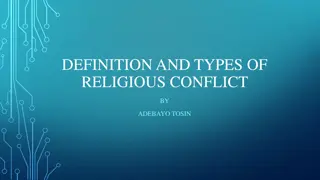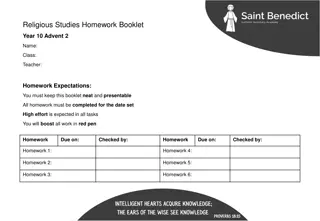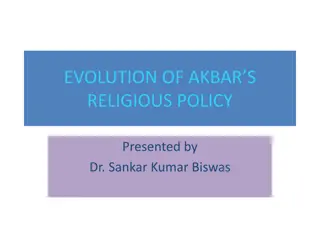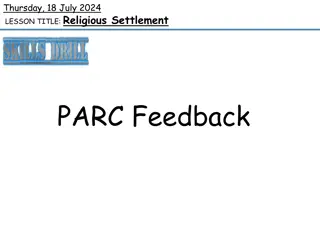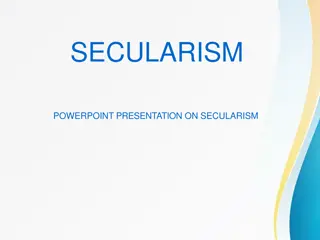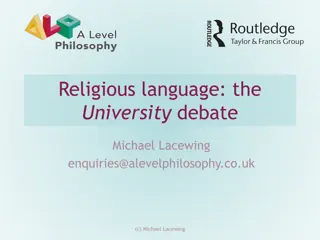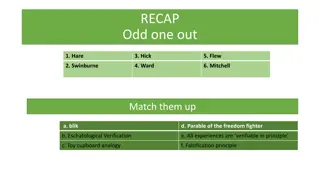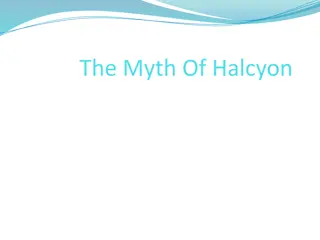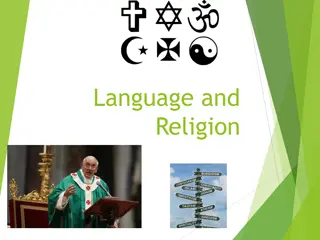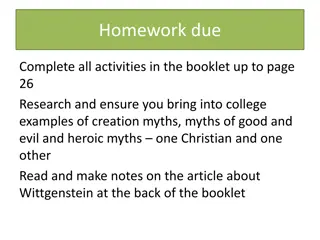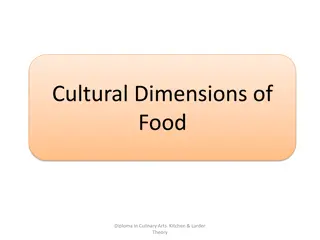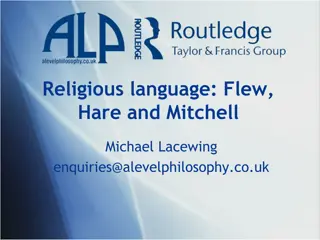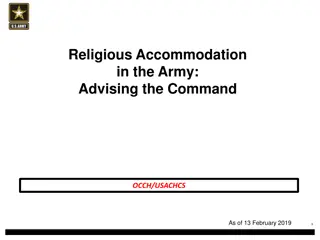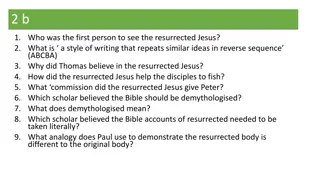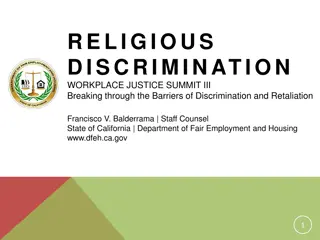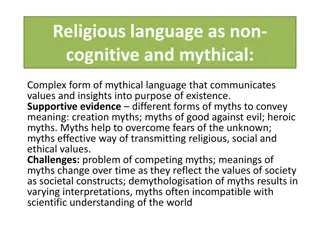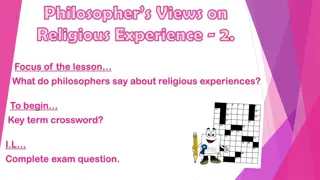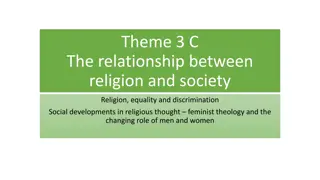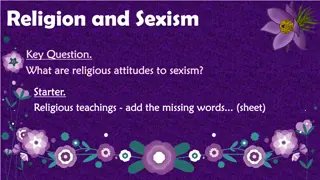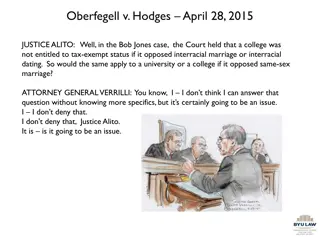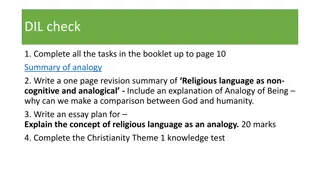Understanding Myth as Religious Language: Exploring Concepts and Interpretations
Explore the multifaceted nature of myths as religious language, delving into their equivocal definitions, truth claims about God, and use of rhetorical devices. Discover the significance of myths in providing human understanding of God, revealing divine attributes, and addressing fundamental questions through stories like Creation, Noah's Ark, and Jesus' Resurrection. Dive into form criticism and its implications on biblical interpretation, considering the evolving perspectives on religious texts.
Download Presentation

Please find below an Image/Link to download the presentation.
The content on the website is provided AS IS for your information and personal use only. It may not be sold, licensed, or shared on other websites without obtaining consent from the author. Download presentation by click this link. If you encounter any issues during the download, it is possible that the publisher has removed the file from their server.
E N D
Presentation Transcript
Understanding Myth as Religious Language
Definition of myth Used differently in a religious philosophical context (equivocal) It is a written (textual version) of an oral tradition Not necessarily historically accurate but may contain elements of History (Israelites slave of the Egyptians, floods) Historical accuracy not the point. Also in 21st c. we have a different understanding of History
Definition of myth Have truth claims about God. Gives human understanding of God, reveal attributes of God Contains truths about human purpose Give an appreciation/understanding of God s majesty Awe and Wonder. Rudolf Otto the Numinous or Wholly Other. Inspirational. Myths pre date science, accepted theology, philosophy and doctrine
Tasks Write a definition of miracle, give examples from the myths we have looked at What rhetorical devices are used in mythical stories? Explain the fundamental questions that are being addressed in 3 of the following (one must be from the N.T.): Creation, Noah, Tower of Babel, Plagues, Daniel, David and Goliath, Jonah, Jesus birth, Jesus Resurrection 1. 2. 3.
Answers Use key terms Examples could include God as creator: Transcendence, omnipotence. God as judge Flood God s immanence Jesus incarnate God with power over death Resurrection Allegory, analogy, metaphor (give an example for each) Discuss the points in groups between write deifinative)
Form criticism European, German, many scholars Jewish. Developed in 19/20c. By Hermann Gunkel 1862 1932 To understand the meaning of Biblical text must look at the Sitz im leben (Setting in life). Coin first used in 1906 Sitz im volksleben setting in life of the people. Need to look at the context the text is written in It should not be confused with sociological study. This is Biblical exegesis- critical interpretation of a text N.B. Biblical but now applied to other texts. 1. 2. 3. 4.
Implication of form criticism If you apply form criticism it means that possibly messages in the Bible are not universal and for all time, therefore the Bible is open to interpretation. It is this that led to the growth of Christian fundamentalism especially in USA at the turn of the 20thcentury. These rejected form criticism and developed a movement (now rather influential) in support of Biblical literalism. Form criticism was seen as further evidence of the secularisation of society. Accounts for growth in fundamentalism in all major world religions
Scholastic approaches Rudolf Bultmann 1884 1976 Strength or weakness 1941 New Testament and Theology. Not an advocate of myth, rather exposing how Christians have thought mythically. No longer rational for Christians to accept a mythical view of the N.T. We can not use electric lights and radios and, in th eevent of illness, avail ourselves of modern medical and clinical means and at the same time believe in the spirit and wonder of the New Testamnet To interpret N.T. mythology in cosmological terms, as a description of the universe, is not plausible. The interpretsion must be superseded by an anthrpological interpretaion that discloses the truth of the kerygma .
Kerygama New Testament Greek Preaching/ to cry to proclaim it is about Jesus ministry. Can see this in work of M.L.K. And liberation Theologists. The whole conception of the world which is presupposed in the preaching of Jesus as in the New Testament generally is mythological, i.e., the conception of the world as being structured in three stories, heaven, earth and hell; the conception of the intervention of supernatural powers in the course of events; and the conception of miracles, especially the conception of the intervention of supernatural powers in the inner life of the soul, the conception that men can be tempted and corrupted by the devil and possessed by evil spirits.
Gospels are a unique form of literary genre. The Kerygma or preaching as a literary form. The oral tradition of the gospels. You need to separate out the myth from the message. Therefore Jesus walking on water is about helping others. This again is where we can see the influence in social ministries of the latter 20thc.
John Hick strength or weakness Edited the controversial The myth of God incarnate 1977 seen as ground breaking. Contributors included John Hick and Maurice Wiles. Jesus not God in human form. This idea not new e.g. Pharaohs and Avatars in Hinduism I suggest that its character is best expressed by saying that the idea of divine incarnation . See hand out
John Macquarrie 1919 2009 Scottish strength Myths are about why not how. Give insights into man s relationship with God Religious language is rooted in myth. This is how humans know of God s attributes. They are fictional stories conveying an objective truth Bible is full of stories. Are the Gospels in story form? Tsk. 2 columns, heading 1 Story heading 2 attribute
Emile Durkheim French 1858 1917 Fr. Sociologist Weakness Myths are constructs of society No objective reality Society changes therefore myths or meanings change.
Ninian Smart 1927-2001 Phenomenologist Myth is one of the 7 phenomena of religion(Neutral way of studying religion. Allows for the comparative study of religions. Hold back on beliefs and judgements.
Tasks What do you think are the 7 phenomena of religion? Explain the impact of form criticism on Myth and religious language. Write down strengths and weaknesses
types of response Literalist What does mythical language mean to them Conservative thinkers what does it do for them Liberalists What is the purpose of mythical language? What is successful in achieving?
Starting to compare Via Negativa Analogy Myth Symbol For each one list strengths and weaknesses using scholars How are they similar and how are they different?



